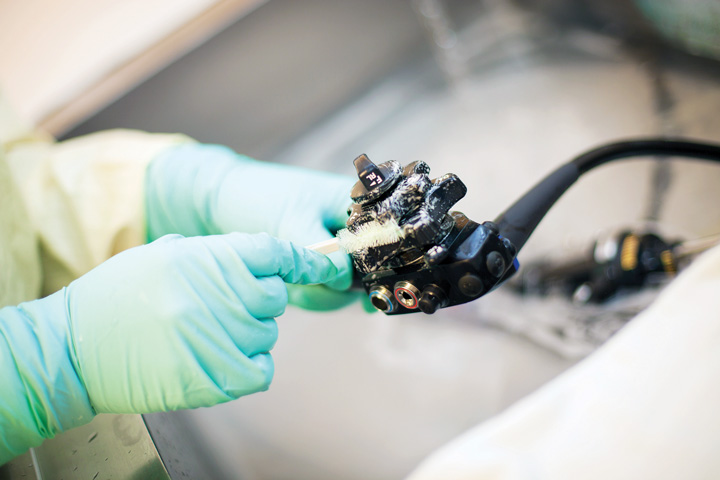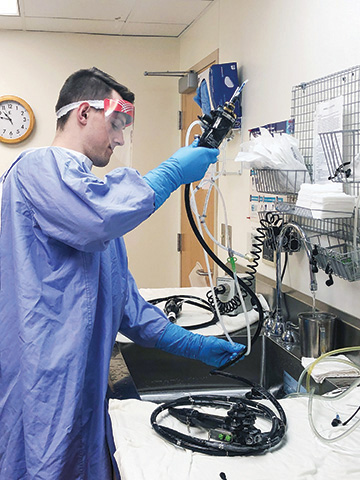- Home
- Article
Standardize Flexible Endoscope Reprocessing
By: Keith Loria | Contributing Editor
Published: 8/14/2023
Here’s how to improve safety and reduce the likelihood of devastating infections.
From out-of-date IFUs to inconsistent guideline usage to precleaning variables to poor training and lack of certification, plenty of issues can crop up to negatively impact your sterile processing department’s (SPD’s) endoscope reprocessing efforts.
Standardizing those efforts and eliminating breaks in the chain of command are the best ways to combat these safety and efficiency issues.
Depending on the variability of your facility’s processes, this can be a major undertaking. But it’s well worth it when you consider the consequences of improperly cleaned and reprocessed endoscopes. When best practices aren’t consistently applied, the result can be healthcare-associated infections (HAIs) that cause life-threatening consequences for patients.
Facilities significantly lower these risks and the poor outcomes they bring about by standardizing practices wherever possible and putting in place watertight guidelines. Here’s how to tackle the complex task of reprocessing your scopes exactly the same way every time.
Start with the system
Until there’s a standardized universal checklist for endoscope reprocessing, it’s up to facility leaders to use the most thorough guidelines available — and the manufacturers’ IFU — to reduce variation. Easier said than done.
Damien Berg, BA, BS, CRCST, AAMIF, vice president of strategic initiatives at the Healthcare Sterile Processing Association (HSPA), recently worked with a health system that operates three hospitals and a surgery center. The system needed advice on standardizing its endoscope reprocessing.
“The key to understanding standardization comes down to the equipment that you have — not only the scopes, but the brushes, ancillary equipment and reprocessing equipment — and your staff,” says Mr. Berg. “Are you talking different staff and leadership or the same people at different sites who rotate? That leads to the decisions made on standardizing and what will stick.” He says a good place to start is to inventory all of your scopes and accessories to determine what is needed to tighten everything up, so no one is using the wrong thing. “Having this level of organization, for starters, will allow your staff to be able to find everything,” adds Mr. Berg. “Also, it’s especially important when reprocessing endoscopes to use color-coding and wayfinding systems to create a clearly defined system that provides a step-by-step guide to every move in your process.”
When it comes to staff, everyone has a different level of experience. Mr. Berg says the idea is to match their varying skill levels with standardized training, whether it be initial onboarding, annual competency or further training.
It’s also important to follow the established recommendations and guidelines offered by reputable organizations such as the World Health Organization (WHO), the Centers for Disease Control and Prevention (CDC), and professional societies like the American Society for Gastrointestinal Endoscopy (ASGE) or the European Society of Gastrointestinal Endoscopy (ESGE).
These recommendations can eliminate ambiguities from this very complex procedure by outlining the optimal methods for reprocessing. When you direct staff to follow specific association guidelines to the letter, there’s less of a chance of different leaders or staff misinterpreting steps regarding precleaning, leak testing, or transport and storage.
Combat breaks in command
Standardization efforts often come down to identifying and eliminating various breaks in the chain of command that exist — and implementing airtight protocols to prevent those issues from reoccurring. One key to ensuring this is a smooth process is to foster an atmosphere of open communication and cooperation among all parties involved in endoscope reprocessing. That includes ensuring everyone in SPD feels confident and supported when calling attention to issues — whether it’s simply questioning why something is being done a certain way or overtly correcting incorrect practices.
Streamline for safety
You can also look to technologies designed to make life easier for reprocessing technicians. For instance, Uggen Jigmey, director of central sterile processing for the supply chain administration at Hennepin Healthcare in Minneapolis, says his facility overhauled its processes and looked to streamline areas where problems could occur by devising a one-way flow (or passthrough) of reprocessing to ensure steps are executed correctly throughout by separating dirty and clean environments.
“We achieved this by using a passthrough automated reprocessor combined with a storage cabinet system that eliminates the need to handle the scope,” he says. “We also use flushing aids in manual cleaning of the scopes.”
Regular review

Endoscope reprocessing procedures should be examined regularly and adjusted to accommodate new information, technical developments and input from personnel and specialists.
It’s vital to keep up with developments in the field, including recent findings and recommendations, to ensure your facility’s protocols current.
Mr. Berg notes that breaks in command are not isolated to just endoscope reprocessing, but happen because leaders tend to live in “firefighting mode,” which leads to reactive and corrective approaches to problems as they occur.
“At my facilities, we are not in that firefighting mode, which allows leaders as a command to have good oversight and support the people doing the work and advance what they needed,” he says. “But if the leader is constantly on the defensive with the clinical team and/or hospital leadership team, whether it’s damaged scopes or quality issues, then you’re living in that world where you’re not allowed to have the freedom to standardize those processes.”
That’s important because you need to know what’s being done wrong and why it’s happening in order to put new steps in place to stop issues and get to a place where processes are being done better.
Out-of-date IFUs are a red-flag issue that leads inconsistent or incorrect habits, but this problem is changing for the better. Mr. Berg co-chaired the AAMI working group that completely revamped TIR12, creating its new 2020 version, which tells manufacturers how to standardize their IFUs.
The working group determined early on that even though manufacturers and test labs have been validating IFUs all along, the conditions and terminology they have used were not always an apples-to-apples comparison to the rapidly changing environments in the clinical setting.
“This has been out for about two years now and has been accepted among the FDA community, regulatory community and manufacturers of new products coming out on the market,” he says. “Any new product on the market must comply with TIR12, which standardizes the challenges — inaccurate IFUs or confusing IFUs that conflict with other devices or other products.”
According to AAMI, “This TIR [technical information report] can serve as a resource for identifying the questions healthcare personnel should ask manufacturers when considering a product for purchase or when devising a processing protocol for a product already being used.”
Poor training and lack of certification

Competency of personnel is essential for endoscope reprocessing, as is proper training and continued education for these employees.
That’s why it’s necessary to create thorough training curricula that encompass cleaning, disinfection and sterilization procedures along with other reprocessing-related topics.
Training has always been a problem in endoscope reprocessing, says Mr. Berg, who notes that reprocessing endoscopes is a highly complex and ever-evolving skill. “It’s not something you train in once and say, ‘I’m good,’” he says. “You need to constantly go back at it — it’s no different than what a pilot does or what nurses do with their checklist. They need to constantly keep up with the latest changes. The challenge is that training does not typically have an ROI on it for most facilities. Sometimes training is first thing to get cut.”
Training and education are broad terms that could mean internal training, sending staff to industry conferences and workshops, or purchasing necessary study materials. Education of technicians through a certification program is also key to ensuring consistent knowledge and understanding among your staff. “Restraints and restrictions are one of the last things we want to do,” Mr. Berg says. “We don’t want to cut safety, and we need to figure out how to find the time and money for training, especially in an endoscopy suite where you have a lot of technicians that rotate between the clinical procedural room and the decontamination area.”
Reputations are at stake
The safety of your patients is more than enough justification for imposing stringent reprocessing protocols and making sure your staff does everything by the book — every time.
Flexible endoscopes can spread hazardous pathogens including bacteria, viruses and even prions if they aren’t adequately cleaned, disinfected and sterilized before they are used in a variety of diagnostic and therapeutic procedures.
The risk of HAIs is reduced significantly when gastroenterology facilities craft protocols that standardize their endoscope reprocessing. The ultimate beneficiaries of such standardization, of course, are your patients.
Nothing is a better incentive than improved patient safety, of course. By staying on top of the latest developments, guidelines and IFUs, and effectively educating your SPD techs on proper protocols, your patients will be safer. OSM
.svg?sfvrsn=be606e78_3)
.svg?sfvrsn=56b2f850_5)